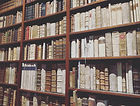
THE BASICS
Cover
Cloth
3 cups
Blueberries
Fillet
Black ink
Spine
Book Board
Title
Gold Emboss
Hinge
Tail
Head
Stamping
Black ink
Book Board- or backboard, is most usually heavy cardboard for hardback books or card-stock for paperback books
Binding- refers to the sewn portion the book but can also refer to different types of sewing, like overhand, coptic, sew-in-fold, and others. Every binder has a different binding technique
Case- the book board and spine backing covered in material (leather, cloth, buckram) that will serve to encase the text block once glued in
Cover- the material, cloth, leather, buckram, etc., that literally covers the book board and which can be designed, embossed, and colored before it is glued to the book board
Fillet- most usually a border of inlay/embossing/ stamping that surrounds the rest of the cover text
Folio- a sheet of paper folded once to create two leaves, and so four pages
Footnotes- the notes at the foot, or bottom, or tail edge, of the page. Often referencing a portion of the text above it, marked by superscript numbers
Fore-edge- edge of pages that are facing out, unsewn, from the book, opposite and parallel to the spine
Gutter- the inside margin of a bound book, against the binding edge, opposite the fore-edge margin
Illustration
Itaglio
Gutter
Marginalia
Begin
Binding
Page Number
Typeface
Footnotes
Fore-Edge
Headband
Subheader
Running Header
Margin
Gutter- the inside margin of a bound book, against the binding edge, opposite the fore-edge margin
Half title- early page with only the title printed on it, usually directly after the first endpaper; not on every book
Head- top of the book's spine or back, where the title is facing up and the book can be opened to its first page
Headband- ornamental band of fabric with a run of color, usually striped, at the top. Meant to imitate early binding techniques which sewed headbands into the text block to protect the head and tail of the book
Hinge- space between the book board and the spine support that helps the cover lay flat when the book is opened. Also refers to a portion of board that is added to the spine to make sections of a book lay flat
Illustration- usually refers to a drawing or picture that is meant to illustrate or demonstrate the text. Can be printed in a variety of different ways depending on the period or area of print production
Intaglio- type of image printing, which consists of a design or illustration being etched into a piece of material, usually thin metal, and rolled over with ink, and a blotter is then applied to take the ink off of the material except where it will remain in the grooves. Then the paper to be printed on is laid over top and pressed with a heavy roller so that the image is then transferred fully to the page
Lithography- the process of illustration printing that is done on limestone with waxy, ink-attractive crayons, transferred to damp paper using careful pressure and a special press.
Margin- blank edges surrounding text
Marginalia- written notes in the margins
Octavo- a sheet of paper folded three times to create eight leaves, and so sixteen pages
Page Number- the number at the top of a page marking its position in the book. Is not often used on front or back matter, like title pages or indexes
Running Header- most usually the chapter name, though can be the book title or the author, which appears on every page at its top, or head
Spine- or back of the book, covering the binding edge and connecting the front and back book boards to the book block
Stamping- embossing with a full illustration or die-cut
Sub-header- usually a title for a section of a chapter, printed wider or bolder than the rest of the typeface
Tail- bottom of the book's spine or back, where the title is facing up and the book can be opened to its first page
Textblock- the whole paper matter of the book, including the front and back end pages, sewn together or glued
Title- the name of the book, usually shown on both the spine and the front cover of the book
Typeface- the text within the book, compiled together and printed within the same font, usually, or spaced and written differently to reflect different uses
Quarto- a sheet of paper folded twice to create four leaves, and so eight pages
Quire- collection of pages, one within another (usually eight leaves, so two sheets of paper) that is sewn into a book or sewn together
Woodcut- an illustration cut in relief on a block of wood that would then be inked and put into the printing press to have the paper passed over it


